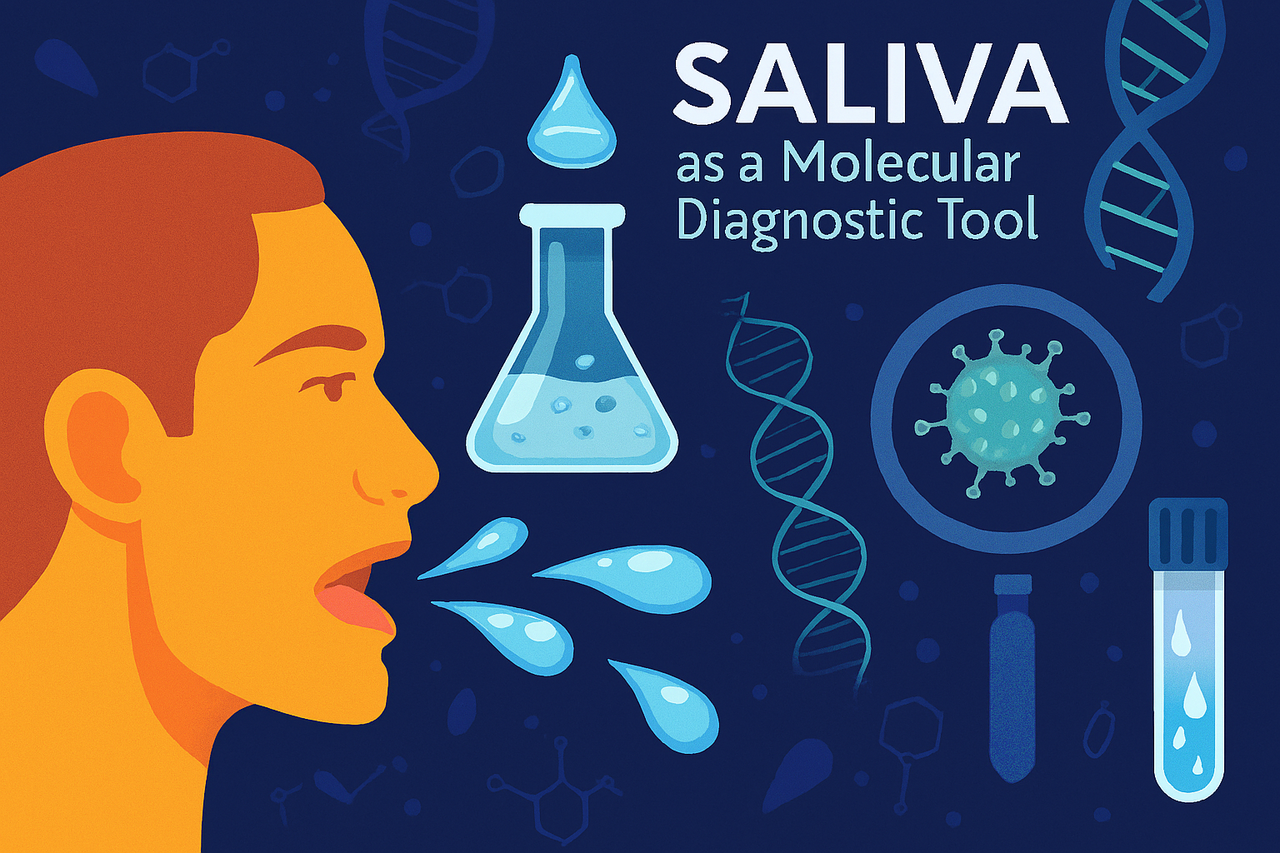Saliva as a Molecular Diagnostic Tool
Published in General & Internal Medicine

Introduction:
For decades, blood has been the gold standard for molecular diagnostics. But what if the same or even more information could be obtained from something far simpler and entirely non-invasive: saliva?
Today, saliva has emerged as a powerful diagnostic fluid capable of revealing the molecular signatures of not only oral diseases but also systemic, infectious, autoimmune, and even malignant disorders. Advances in molecular pathology and high-throughput omics technologies have transformed saliva into a “liquid biopsy,” mirroring the physiological and pathological state of the entire body.
Why Saliva?
Saliva is a complex mixture of water, electrolytes, enzymes, mucins, hormones, DNA, RNA, microRNAs (miRNAs), proteins, metabolites, and extracellular vesicles. Unlike blood, its collection is:
-
Non-invasive – No needles or discomfort.
-
Safe and repeatable – Ideal for large-scale screening and monitoring.
-
Cost-effective – Requires minimal equipment and trained personnel.
-
Stable – Certain biomarkers remain intact under proper storage and processing conditions.
Because it reflects both local oral and systemic molecular changes, saliva has become a window into multiple disease processes.
Head & Neck Diseases:
Salivary diagnostics have transformed the landscape of oral pathology. In oral squamous cell carcinoma (OSCC), several molecular signatures including TP53 mutations, EGFR overexpression, and upregulation of miR-21, miR-31, and IL-8 can be detected in saliva, enabling early detection and recurrence monitoring.
In oral potentially malignant disorders like leukoplakia or lichen planus, salivary miR-155, cytokines (IL-6, TNF-α), and oxidative stress markers (8-OHdG) provide insight into disease activity. Similarly, periodontal disease is diagnosed through bacterial DNA (Porphyromonas gingivalis, Tannerella forsythia) and host response biomarkers like IL-1β and MMP-8.
Even Sjögren’s syndrome, once reliant on invasive salivary gland biopsies, now finds diagnostic potential in salivary RNA profiles particularly anti-Ro/SSA and anti-La/SSB–associated transcripts and miR-574-5p expression.
Infectious Diseases: Detecting Pathogens Without Blood:
During the COVID-19 pandemic, saliva-based RT-PCR became a global standard for SARS-CoV-2 detection. This success accelerated research into other pathogens detectable via saliva:
-
HIV-1 RNA and antibodies.
-
Hepatitis B & C viral nucleic acids.
-
Human papillomavirus (HPV-16/18) DNA in oropharyngeal cancers.
-
Mycobacterium tuberculosis IS6110 PCR.
-
Epstein–Barr virus (EBV) and Cytomegalovirus (CMV) DNA in immunocompromised. patients.
These assays highlight saliva’s potential as a diagnostic matrix for infectious disease surveillance and personalized patient monitoring.
Systemic and Neurological Disorders:
Beyond infection, salivary biomarkers are proving useful in detecting systemic conditions:
| Disease | Key Salivary Biomarkers |
|---|---|
| Diabetes Mellitus | miR-126, miR-200b, amylase, AGEs |
| Cardiovascular Disease | CRP, troponin fragments, miR-1, miR-208a |
| Chronic Kidney Disease | Cystatin C, urea, oxidative stress metabolites |
| Neurodegenerative Disorders | α-synuclein (Parkinson’s), β-amyloid and tau (Alzheimer’s) |
| Psychological Stress / Burnout | Cortisol, α-amylase, miR-21 |
Such biomarkers could enable early, non-invasive monitoring of disease progression and treatment efficacy especially valuable for chronic disorders requiring frequent testing.
Cancer Diagnostics Beyond the Oral Cavity:
Saliva harbors genetic and epigenetic signals shed from distal tumors, making it useful for non-oral cancer detection. Examples include:
-
Breast cancer: miR-21, miR-1246, and CEA mRNA.
-
Lung cancer: EGFR mutations, miR-31, miR-200a.
-
Pancreatic cancer: KRAS mutations, MUC1 mRNA.
-
Colorectal cancer: p16 and MLH1 methylation.
-
Prostate cancer: PCA3 and TMPRSS2-ERG transcripts.
Emerging salivary exosome sequencing and lab-on-chip PCR systems promise real-time cancer screening in primary care settings.
Autoimmune, Endocrine, and Genetic Disorders:
In systemic lupus erythematosus (SLE), miR-21 and miR-146a reflect immune dysregulation, while rheumatoid arthritis can be tracked via IL-6 mRNA and miR-155 expression. Cystic fibrosis gene mutations (CFTR ΔF508) and thyroid disorder markers (TSH, TPO, miR-146b) are also measurable in saliva, reflecting the tissue’s diagnostic versatility.
The Future of "Saliva-Omics":
The next decade will see integration of multi-omics approaches genomics, transcriptomics, proteomics, and metabolomics from a single salivary sample. Microfluidic “lab-on-a-chip” platforms and AI-driven biomarker analysis will soon make it possible to diagnose complex diseases in minutes, at the chairside or bedside.
In precision medicine, saliva will play a central role in risk prediction, early detection, and treatment response monitoring, especially in oncology, autoimmune, and neurodegenerative disorders.




Please sign in or register for FREE
If you are a registered user on Research Communities by Springer Nature, please sign in